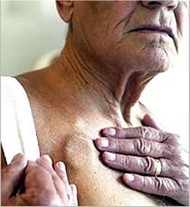 Permanent Pacemaker |
PacemakersContents • What Is A Pacemaker? |
Guide To Irregular Heartbeats |
What Is A Pacemaker?
An artificial pacemaker (image) is a medical device which is implanted under the skin of the chest and is used to replace the heart's natural pacemaker. It helps to regulate a person's heart rhythm. If it detects that the heart is beating too slow it will emit small impulses to tell the heart to beat faster, thus preventing a person experiencing blackouts or dizziness. Today most pacemakers also have a clever demand sensor that can not only speed up your heart rate but also slow it down in response to your activity level. Pacemakers are about the size of a man's watch and have one or two leads which are threaded directly into the heart. For people with congestive heart failure a third lead may be necessary. The procedure for inserting a pacemaker is very low risk and is performed with a mild local anesthetic to the chest area. Over 400,000 procedures are performed every year in America.
What Types Of Pacemakers Are There? There are two types of pacemakers - temporary and permanent:
Permanent pacemakers on the other hand are surgically placed underneath the skin in the chest area and can remain in place for up to 15 years before they need replacing. Pacemakers with:
Most pacemakers are implanted in people whose heart beats too slowly as a result of old age, heart disease or heart medications. Most will have been diagnosed with arrhythmias (such as atrial fibrillation), a condition where the electrical impulses in the heart do not work correctly. For more information see: causes of arrhythmias. How Do They Work? Pacemakers do not give your heart an electrical shock. If a person is at risk of sudden cardiac arrest, usually because they suffer one of the most dangerous types of arrhythmias that can cause the heart to suddenly stop beating, they may be given a different type of device called an implantable cardioverter defibrillator (ICD). An ICD is slightly larger than a pacemaker and is inserted under the skin in the same way. Most ICDs also act as a pacemaker but they have the added advantage of being able to provide an electric shock when they detect life-threatening arrhythmias such as ventricular fibrillation The electric shock kick-starts the heart into beating rhythmically again. Pacemakers are inserted under a local anesthetic to the chest with sedation, so you will feel quite sleepy. The surgeon will make a small incision in the skin underneath the collarbone. The thin lead(s) of the device are threaded through the veins and positioned in the heart; the doctor is guided by X-ray throughout. The surgeon will then connect the lead(s) to the pacemaker device and the unit is slipped under the skin. You will notice a small permanent bump at the site after surgery. The surgery takes between 1 to 2 hours and complications are very rare (about 1 percent of cases). Infections around the pacemaker are rare but if they do occur the pacemaker will be removed. Occasionally it will need to be repositioned. You can return to your routine within a few days, although you are not allowed to drive a car for at least a week. Patients need regular checkups every 3 to 6 months for monitoring (although this may be more frequent after the procedure until the site of incision completely heals). Your doctor will check your pacemaker by moving an electronic programmer over the device. The programmer can relay information about the device such as how it is functioning and the life of the battery. When the battery starts to wear down the pacemaker starts to slow down. While you will not detect this, the programmer can pick this up. When a new battery is needed, a new device will need to be implanted. The procedure is normally quicker because the leads can remain in place. The average battery lasts anywhere between 8 and 15 years. Your doctor may also recommend cardiac rehab to help you recover safely. Certain patients may also undergo special tests to check how their heart rate is doing with the new device - diagnostic tests include a 24 hour Holter Monitor test (image) or EKG (image). Magnetic Fields
|
| Related Articles on Artificial Pacemaker
For more on irregular heart problems, see the following: • Symptoms of arrhythmias: When to call a doctor. Back to Homepage: Womens Health Advice |
|
WOMENS HEALTH ADVICE: ABOUT HEART ARRHYTHMIA |